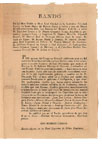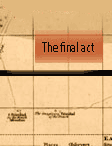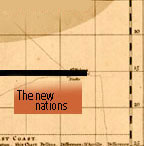| |
The Age of Spanish American Revolutions:
Formation of local juntas and the Spanish attempt to retain control
Napoleon’s invasion of the Iberian peninsula and the forced abdication of Fernando VII and Carlos IV created a crisis of sovereignty: in the absence of the King, where does sovereignty lie? Various localities both in Spain and in the Americas created juntas to govern in the absence of a clear Royal authority. This situation created confusion, with some juntas claiming authority over others, notably, Seville’s junta claimed authority over the Americas based on it historical relationship with the Americas as the sole port of export.
From this confusion emerged the Supreme and Central Governmental Junta of Spain and the Indies. The Central Junta summoned the Cortes, Spain’s legislative body, with representatives from the provincial juntas and those in the Indies. Meeting in Cádiz, in January of 1810, the Central Junta dissolved itself and formed the Council of Regency that, along with prosecuting the War of Spanish Independence against Napoleon’s forces, drafted Spain’s first constitution. Divided between liberal and conservative factions, the liberals ultimately prevailed and drafted the Constitution of 1812, which saw a limited monarchy, with Royal ministers subject to parliamentary oversight. Although the Constitution of 1812 was crafted with participation of American delegates, elevating the status of Spain’s American possessions and ensuring greater local sovereignty, American juntas saw the dissolution of the Junta Central and creation of the Council of the Regency in 1810 as a usurpation and local struggles for Independence from Spain emerged in many parts of the Spanish empire. |
|
|
 Venezuela declares independence Venezuela declares independence
Lallement, Histoire de la Colombie (Paris: Alexis Eymery, libraire, rue Mazarine, no. 30, 1826).
The Council of the Regency of Spain was established on 29 January 1810, after the dissolution of the Central Junta. Representatives of the regency government arrived in Venezuela on 18 April 1810, which provoked no small consternation among local creoles. They convoked an open meeting, a cabildo abierto, which met the following day. The cabildo formed the Supreme Junta to Preserve the Rights of Ferdinand VII, and deposed Spanish officials, including the Capitan General. After the formation of a Congress, independence was formally declared on 5 July 1811. The region was highly divided, however, between Royalists and Republicans, and was battered by civil war almost from the start. A devastating earthquake hit Venezuela on Maundy Thursday 1812, the two-year anniversary of the meeting of the cabildo abierto that began the independence process. This was taken as a sign of divine repudiation of the Republican cause, and by August of that year Royalists were again in charge.
Acquired from the estate of Maury A. Bromsen
|
|
| |
|
|
|
Buenos Aires deposes the viceroy
Buenos Aires (Argentina), Bando en la muy noble y muy leal ciudad de la Santisima Trinidad Puerto De Santa Maria De Buenos-Ayres á veinte y tres de mayo de mil ochocientos diez. (Buenos-Ayres: En la Real Imprenta de Niños Expósitos, 1810).
In La Plata, the cabildo abierto met on 22 May 1810, attended by 250 of the most prominent citizens of Buenos Aires. The group was largely composed of creoles, and debated the legitimacy of the Regency government and of recently-arrived viceroy Balthasar Hidalgo de Cisneros, whose appointment had been made by the Junta Central and not the king. Although somewhat divided, the cabildo voted with a strong majority to strip the viceroy of his authority and form a governing junta. This broadside announces the outcome of the cabildo. This period is know as the “May Revolution.”
Acquired from the estate of Maury A. Bromsen |
|
| |
|
|
|
A British observer
Thomas Kinder, Journal of a Voyage to Rio de la Plata. 1808-1810.
Thomas Kinder, War, Revolution & Society in the Rio De La Plata, 1808-1810: Thomas Kinder's Narrative of a Journey to Madeira, Montevideo and Buenos Aires (Oxford: Signal Books, 2010).
Thomas Kinder traveled to Rio de la Plata in 1808, and his diary provides a first-hand account of the period leading up to the May Revolution. It is opened here to the entry from 25 May recounting the cabildo abierto, in which he writes, “Within these few days the People of this Capital have laid the corner stone of the temple of South American Independence, in a manner that in my opinion, does them the greatest credit.” Kinder went on to be one of the major financers of the Argentine republic. Kinder’s manuscript has been transcribed and edited for publication by JCB Fellow Malyn Newitt.
Acquired with the assistance of the Harper fund |
|
| |
|
|
|
Spain attempts to retain control
Spain and Peru (Viceroyalty), D. Jose Fernando De Abascal Y Sousa, caballero del habito de Santiago &c. (Lima: s.n, 1811).
Although in the Americas the first de facto or de jure declarations of independence had been sounded, Spain still sought to maintain its overseas possessions. The Regency government convoked the Cortes, Spain’s legislative assembly, and sought representatives from the Americas. This provided limited representation by American delegates, who were to be chosen by election, and in this broadside the viceroy of Peru advises that both indigenous and mestizo citizens could participate in these elections. Read the entire item on Internet Archive.
Acquired with the assistance of the Special Purchase fund |
|
| |
|
|
|
La Pepa, the Constitution of Cádiz
Spain, Constitucion politica de la monarquía Española (Lima: En la Imprenta de los Huerfanos, 1812).
The Cortes produced the Constitution of Cadiz, a decidedly liberal document foreseeing the separation of powers between an hereditary constitutional monarch and a unicameral legislature, equality of citizens before the law, and the recognition of individual rights, such as education, freedom of the press, and the right to property. As would be expected from such a document, it also suppressed the Inquisition. Despite prohibitions to the contrary, it was published throughout Latin America. Royalists in the Americas hoped that this liberal document would diminish the appeal of the Republican cause. Read the entire item on Internet Archive.
Acquired with the assistance of the Divestiture fund |
|
|
To next section: Early military campaigns |
|














